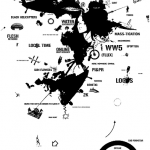Paola Lopreiato
PhD candidate at the Planetary Collegium, CAiiA Hub, School of Art & Media, University of Plymouth
Q (Quanta of Sound (2015)
Three main elements characterise the realization of this installation:
- Reconsideration of acoustic spectrum
2.Analysis and use of acoustic I electromagnetic wave phenomena
3.Use of new media
There are great similarities between the behaviour of electromagnetic wave phenomena and phenomenain the acoustic domain, and those correspondences inspired the work “0” (quanta of sounds). Theinteractive installation akes as its point of origin of the electricity distr buted in
the spectrum of audible sounds generated by the instrument (in this case the voice of audience captured by microphones),treating it and returning it with profound deviations in time and space. The energy distr bution in the spectrum of the acoustic soundis its own identity,its character, a kind of genetic code or fingerprint that makes the event unique and unrepealable. The patch configured with the software MAX I MSPis responsible for analysing the ene gy distribution (energy of sound) by dividing the spectrumin typical critical bands that are also the one with which works the basilar membrane, located in the cochlea. The energy (of the original sound) captured in the 25 critical bands will be analysed and then returnedin time in small packets (quanta) no longer in a synchronized manner but with appropriate time intervals that make more distinct and perceptible their presence,opening like a ray of light refracted by a prism. Simila/ly,the or ginal sound source (where the microphonestpeople’s voice are located) will no longer be the location (not the only one) of the •quanta of energy” which will nstead be projected in the surrounding acoustic spacein every direction. Thanks to this irradiation in time and space,the energy contained in the acoustic spectrum will be perceivable in a direct way in its essential components. The energy distribution in the spectrum of the acoustic sound is its
identity while the quantization process andirradiation of the acoustic energy in different time and
directions provide an opportunity for exploration of the sound generated by people’s voices and this process will highlighting new variations of that identity of the sound,normally trapped in the structure of the sound itself.The release of the energy within the sound and its expression through this alchemical process put in place by the new dimensions of space and time,define a new identity or better yet a different way of reading what is happening.
info : www.i-node.org







